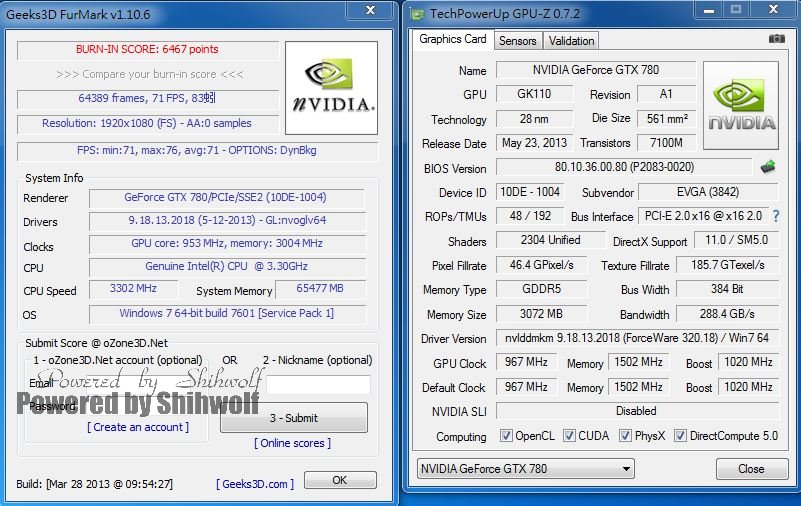
Furmark 1 9 0 Exemptions
NVIDIA Updates Chip Package Materials, 55nm GPUs subject to Changes too. Dec 26th 2018 Version 4.6.0 beta 10 of MSI Afterburner Introduces OC Scanner for Pascal (56) Oct 19th 2018 NVIDIA Rushes in GTX 1060 with GDDR5X to Counter AMD Radeon RX 590 Threat (98).
You might not realize it, but you’re required to pay your taxes throughout the year, rather than making one big payment at the end of the year. If you’re thinking that isn’t a requirement because you’ve never written a check to the IRS during the year and haven't yet been penalized, it’s because you satisfy your tax obligations through income tax withholding from your paycheck. To avoid being hit with interest and penalties, you must meet one of the tax payment safe harbors outlined in the tax code. If you owe less than $1,000 when you file your taxes, you won’t owe any interest or penalties.
You also avoid interest and penalties as long as your withholding totals at least 90 percent of what you owe for the current tax year. For example, if your tax bill this year ends up being $7,750, you would need to have at least $6,975 in withholding during the year to meet a safe harbor. You would still owe the difference when you file your taxes, but you won’t owe any additional interest or penalties. Another safe harbor allows you to avoid interest and penalties based on your prior year’s tax liability. The IRS recognizes that income can vary from year to year, and offers a way to avoid interest and penalties if your income unexpectedly spikes. To qualify, your withholding must equal at least 100 percent of what you owed in taxes the prior year if your adjusted gross income was $150,000 or less ($75,000 or less if married filing separately). Huawei unlock software free download.
For example, if last year you owed $8,000 in taxes, you avoid interest and penalties if your withholding this year is at least $8,000, regardless of how much you owe. For the 2018 year, each allowance you claim reduces your income subject to withholding by $4,150 over the course of the year. That amount is spread over the year based on how often you’re paid. For example, if you’re paid weekly, each allowance reduces the amount of your paycheck subject to withholding by $79.80, but if you’re paid biweekly, the value of each allowance increases to $159.62. So, if you claim one allowance and your weekly paycheck is $779.80, only $700 will be counted when determining your income tax withholding. But, if you claim zero allowances on your Form W-4, your entire $779.80 paycheck will be counted when your employer determines how much to withhold.
Free lal kitab prediction in bengali. If you work multiple jobs, or if you’re married and your spouse also works, you need to consider how many allowances you are claiming on each Form W-4. To help you get the most accurate withholding, use the Two-Earners/Multiple Jobs Worksheet. This worksheet is specifically designed to calculate the total number of allowances you should claim across all your jobs and your spouse’s jobs. Typically, it’s best to claim all the allowances on the highest-paying job and then claim zero allowances on the Form W-4s for your remaining jobs. If you have too little withheld from your paychecks during the year, you’ll owe interest and late payment penalties based on the shortfall.
On top of that, you could also face a $500 penalty if the IRS determines that you claimed allowances you had no reasonable basis for claiming on your Form W-4. For example, if you claimed eight allowances because you wanted to reduce your tax withholding, but then ended up having too little withheld for income taxes and you couldn’t show your basis for claiming so many allowances, you could owe the penalty. Just because you filled out your Form W-4 when you started working doesn’t mean you don’t need to update it from time to time. After major life events, such as getting married or divorced, having a child, a child becoming an adult, or taking on a new job or side gig, you should review the information you provided and update it if needed to make sure the total number of allowances you are claiming is still correct. In addition, if there are major revisions to tax laws, you should review your Form W-4 to make sure that your tax withholding is still accurate for the new changes.
Payroll taxes include the Social Security tax and the Medicare tax. These taxes only apply to earned income, like your wages and salaries, but not investment income. In addition, these taxes aren’t affected by the same deductions as federal income taxes, so the amounts withheld aren’t affected by the allowances you claim or the filing status you select on your Form W-4. Instead, Social Security taxes are withheld at a rate of 6.2 percent and Medicare taxes are withheld at a rate of 1.45 percent, and your employer pays an equal amount on your behalf.